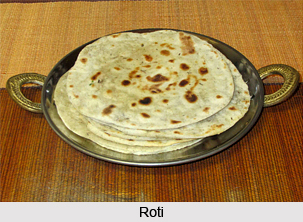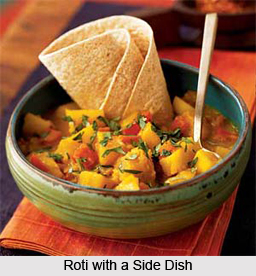 Roti is an Indian food and is the generic Indian name for baked, grilled or roasted products. The word roti is derived from a Sanskrit word which means "bread". This food is regarded as one of the staple diets of the country and is mostly based on wheat flour and also derived from rice, jowar, bajra, maize.
Roti is an Indian food and is the generic Indian name for baked, grilled or roasted products. The word roti is derived from a Sanskrit word which means "bread". This food is regarded as one of the staple diets of the country and is mostly based on wheat flour and also derived from rice, jowar, bajra, maize.
History of Roti
Roti literally resembles the word karoti which finds its mention in the medieval Ramcharitamanas in 1600 century AD of Tulsidas. Moreover, the word roti is similar to a Sanskrit word, rotika mentioned in a medical text Bhavaprakasa, written by Bharata-mishra in the sixteenth-century.
The Indian food, roti in its unusual kind which is made from wheat is described in Kannada literature between the tenth and eighteenth centuries. This reference has given rise to historical interest. An unusual method of roasting of these rotis is mentioned in this Kannada text. An extensive range of methods mentioned here include baking between plates with glowing embers both below and above and production of mucchala-roti. The kivichu-roti was roasted on a thava which is termed as kavali in Kannada with a little ghee. Several thava-roasted rotis could be consumed with sugar and edible camphor. Chucchu-roti can be prepared from palmyra (thale) flowers. Other mentions of the unusual rotis contain savudu-roti baked under cover of a cup. Uduru-roti comes when a cup cover is put above with burning coals below.
Types of Rotis in Modern Times
Among the exotic roti in Indian food, mandage comes into the list. It is delicately baked product which is white-mandige or ushnavarta-mandige and if exposed to air becomes vayuputta-mandige. In this modern time, mandage is made into large and fine paratha stuffed with finely ground sugar containing cardamom powder which is baked on a large upturned clay pot, and folded when hot and flexible into a rectangle that hardens as it cools.
 Roti as Indian food becomes a wonderful delicacy in its bhojanandika-roti form. Wheat-based rotis in modern Indian cuisines come under three categories. These include dry-roasted on thavas comprising common chapati, rumali, slightly flattened phefras of Rajasthan, the bhatia of the same state is a popular peasant food, and do-patris are soft, thin rotis. Pan-fried rotis are prepared using a little fat, or deep-fried Paratas in a kadhai and rotis which are leavened and baked in ovens and tandoors or a stuffing of vegetables or chopped eggs may be placed on the parata which is then folded over and lightly fried.
Roti as Indian food becomes a wonderful delicacy in its bhojanandika-roti form. Wheat-based rotis in modern Indian cuisines come under three categories. These include dry-roasted on thavas comprising common chapati, rumali, slightly flattened phefras of Rajasthan, the bhatia of the same state is a popular peasant food, and do-patris are soft, thin rotis. Pan-fried rotis are prepared using a little fat, or deep-fried Paratas in a kadhai and rotis which are leavened and baked in ovens and tandoors or a stuffing of vegetables or chopped eggs may be placed on the parata which is then folded over and lightly fried.
Indian roti also includes naan which is made of maida. This food is famous in the northern and western region of India including states such as Hyderabad, Amritsar and Kashmir. In addition to that, this naan can be coated with a tomato and garlic paste, or with a sweet mash of dates. Apart from naan roti, makki di roti and rumali roti also add to the Indian dishes.
Plain Roti as Daily Consumption Food Item:
Despite the availability of roti in various forms, the plain roti is preferred most for daily consumption due to its myriad health benefits. The wheat-based plain roti is enriched with Vitamin E, Selenium and fibre which lowers the risk of cancer and heart disease. It also helps in reducing weight. The added advantage is it can be prepared in a short span of time.
Ingredients of Plain Roti:
•2 cups whole wheat flour
•All-purpose flour - for rolling and dusting
•4 tsp oil
•1/2 tsp salt
•3/4 cup warm water
Method of Preparing Plain Roti:
•In a large mixing bowl, mix chapati flour and salt well.
•Add oil and mix until all lumps are gone.
•Add warm water a little at a time to form a medium soft dough ball.
•Add few drops of oil and coat the dough ball. Cover and let it rest for 15 minutes.
•Heat tawa or skillet on medium heat.
•Knead the dough once and divide into golf ball size balls.
•Dip one ball into the all-purpose flour to coat and roll it out into a thin disc. Keep dipping the roti into the dry flour to prevent it from sticking to the rolling surface.
•Shake or rub off excess flour from the roti and place it onto the hot tawa.
•Flip to the other side once bubbles appear on the surface. Allow it to cook for 10-15 seconds.
•Increase the stove heat to high, gently pick the roti up with tongs, remove the tawa off of the flame, flip the roti over and place onto an open flame.
•The roti should balloon up. Flip it over and cook on the other side.
•Place the cooked roti into an insulated container and smear it with ghee or clarified butter and repeat the process for the remaining dough.
•Serve.
Side Dishes to go with Roti:
Generally, roti is not consumed alone; it is eaten with various side dishes. Roti can be served by teaming up with dishes like Gobhi Matar Rasedar, Dum Aloo, Tari Aloo, Matar Paneer, chutneys, pickles, raita etc. It can also be relished as a snack item by dipping in hot masala tea.




















